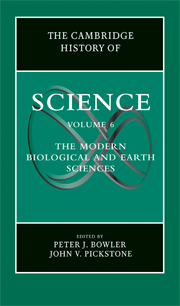Book contents
- Frontmatter
- 1 Introduction
- PART I WORKERS AND PLACES
- 2 Amateurs and Professionals
- 3 Discovery and Exploration
- 4 Museums
- 5 Field Stations and Surveys
- 6 Universities
- 7 Geological Industries
- 8 The Pharmaceutical Industries
- 9 Public and Environmental Health
- PART II ANALYSIS AND EXPERIMENTATION
- PART III NEW OBJECTS AND IDEAS
- PART IV SCIENCE AND CULTURE
- Index
- References
5 - Field Stations and Surveys
from PART I - WORKERS AND PLACES
Published online by Cambridge University Press: 28 November 2009
- Frontmatter
- 1 Introduction
- PART I WORKERS AND PLACES
- 2 Amateurs and Professionals
- 3 Discovery and Exploration
- 4 Museums
- 5 Field Stations and Surveys
- 6 Universities
- 7 Geological Industries
- 8 The Pharmaceutical Industries
- 9 Public and Environmental Health
- PART II ANALYSIS AND EXPERIMENTATION
- PART III NEW OBJECTS AND IDEAS
- PART IV SCIENCE AND CULTURE
- Index
- References
Summary
Buoyed by the combination of optimism of understanding the natural world from Isaac Newton’s version of the mechanical philosophy and the excitement of discovering natural artifacts of the natural world from naturalists such as Carl Linnaeus, Abraham Werner, and Georges Buffon, natural philosophers turned increasingly to studying nature in nature by the end of the eighteenth century and the beginning of the nineteenth century. Certainly the maturation of the cabinet tradition in the form of emerging national museums (Muséum d’Histoire Naturelle, British Museum) and national botanical gardens (Royal Botanical Gardens at Kew) at this same time underscores the importance of learning from the natural world. Furthermore, continued overseas expansion and exploration, especially in North America, the Indian subcontinent of Asia, and Australia, heightened European interests in this direction.
Many of these same eighteenth-century motivations continued into the nineteenth century and, moreover, may be described after the model of scientific transmission and development offered by George Basalla, which he developed by examining the early history of American science vis-à-vis science in England. It is certainly appropriate to borrow from and to expand on Basalla, for much of the eighteenth-century interest in the natural world was exhibited by Europeans who observed nature outside of Europe, primarily within their colonial holdings. They collected specimens on voyages of discovery and recruited local colonialists to collect specimens that could later be sent back to European museums and universities following the return of the imperial explorers to their mother country (see MacLeod, Chapter 3, this volume).
- Type
- Chapter
- Information
- The Cambridge History of Science , pp. 76 - 89Publisher: Cambridge University PressPrint publication year: 2009
References
- 17
- Cited by



